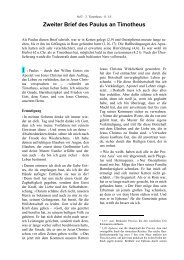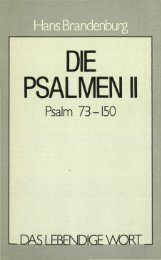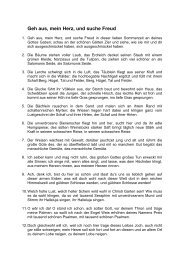Create successful ePaper yourself
Turn your PDF publications into a flip-book with our unique Google optimized e-Paper software.
Whispering 25<br />
Spacious office 50<br />
Motor car cruising smoothly 50<br />
Thunder 65<br />
Noisy street traffic 70<br />
Typewriter 70<br />
Waterfall 90<br />
Freight train 98<br />
Sawmill 100<br />
Jet plane (at 600m height) 105<br />
Disco 114<br />
Prop-driven plane starting up 120<br />
Boilermaking 120<br />
Rock concert 125<br />
Pneumatic drill 130<br />
Artillery fire 130<br />
Testing airplane engines 140<br />
Jet engine starting up 1<strong>45</strong><br />
Let us now consider the structure of the ear.<br />
The auricle: The human auricle, with its attractive<br />
relief of ridges, hollows, bulges, curves and<br />
grooves, is unmistakeably the same in its basic<br />
features, yet is a little different, in each one of us.<br />
The fact that these complex and beautiful forms<br />
play an important part in the hearing process has<br />
only been discovered in recent years.<br />
Sounds are conducted to the external hearing<br />
canal along two different paths, with the result<br />
that the sound travelling along the shorter route<br />
arrives one five thousandth of a second before<br />
the other signal. Given that sound travels at a<br />
speed of 330 m/s, this means that the difference<br />
in path length is about 6.5 cm. This is quite separate<br />
from the time difference between the two<br />
ears, which enables us to locate the source of<br />
various sounds. Such refined accoustic analysis is<br />
fairly essential for us. In effect we are able to<br />
analyse sounds in three dimensions, in such a<br />
way that we can recognise the direction of all<br />
incoming sounds, as well as the location and<br />
motion of their sources.<br />
Vocal communication requires very accurate<br />
identification of the position and movement of<br />
someone who is speaking, as well as of all the<br />
complex sound sequences involved. Since there<br />
are two sound paths for each ear, we virtually<br />
possess four ears. This ingenious system is so<br />
subtly and cleverly designed, that it all happens<br />
without us ever being aware of any doubling or<br />
quadrupling of sounds.<br />
Darwin’s book, The Descent of Man and Selection<br />
in Relation to Sex was published in 1871. In it he<br />
The organ of Corti<br />
<br />
<br />
<br />
<br />
<br />
<br />
<br />
<br />
<br />
<br />
<br />
<br />
<br />
Columnar cells<br />
Spiral ligament<br />
Epithelial cells of the<br />
scala tympani<br />
Supporting cells<br />
(of Hensen)<br />
Outer hair cells<br />
Interior tunnel<br />
Inner hair cells<br />
Internal spiral sulcus<br />
Pillar cells<br />
Cochlear nerve<br />
Bony spiral layer<br />
Edge of the bony spiral<br />
layer<br />
Tectorial membrane<br />
Vestibular membrane<br />
Cochlear duct
















